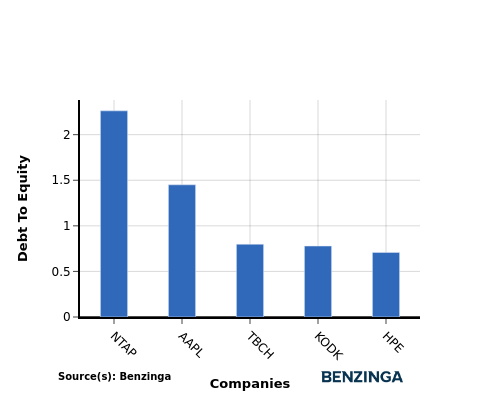
Inquiry Into Apple’s Competitor Dynamics In Technology Hardware, Storage & Peripherals Industry
In today’s rapidly changing and fiercely competitive business landscape, it is vital for investors and industry enthusiasts to carefully evaluate companies. In this article, we will perform a comprehensive industry comparison, evaluating Apple (NASDAQ:AAPL) against its key competitors in the Technology Hardware, Storage & Peripherals industry. By analyzing important financial metrics, market position, and growth prospects, we aim to provide valuable insights for investors and shed light on company’s performance within the industry.
Apple Background
Apple is among the largest companies in the world, with a broad portfolio of hardware and software products targeted at consumers and businesses. Apple’s iPhone makes up a majority of the firm sales, and Apple’s other products like Mac, iPad, and Watch are designed around the iPhone as the focal point of an expansive software ecosystem. Apple has progressively worked to add new applications, like streaming video, subscription bundles, and augmented reality. The firm designs its own software and semiconductors while working with subcontractors like Foxconn and TSMC to build its products and chips. Slightly less than half of Apple’s sales come directly through its flagship stores, with a majority of sales coming indirectly through partnerships and distribution.
| Company | P/E | P/B | P/S | ROE | EBITDA (in billions) | Gross Profit (in billions) | Revenue Growth |
|---|---|---|---|---|---|---|---|
| Apple Inc | 33.73 | 47.82 | 8.22 | 58.74% | $45.91 | $58.27 | 3.95% |
| Hewlett Packard Enterprise Co | 7.80 | 0.84 | 0.71 | 2.39% | $1.11 | $2.29 | 16.27% |
| Super Micro Computer Inc | 13.85 | 3.05 | 0.97 | 5.29% | $0.4 | $0.67 | 54.93% |
| NetApp Inc | 16.62 | 18.62 | 2.91 | 31.69% | $0.45 | $1.15 | 2.18% |
| Western Digital Corp | 12.68 | 1.26 | 0.96 | 4.89% | $0.96 | $1.52 | 41.33% |
| Pure Storage Inc | 146.32 | 11.32 | 4.91 | 3.12% | $0.09 | $0.59 | 11.4% |
| Eastman Kodak Co | 6.99 | 0.79 | 0.56 | 2.46% | $0.05 | $0.05 | -3.27% |
| Turtle Beach Corp | 14.81 | 1.93 | 0.65 | 18.11% | $0.03 | $0.05 | 46.76% |
| Average | 31.3 | 5.4 | 1.67 | 9.71% | $0.44 | $0.9 | 24.23% |
After a detailed analysis of Apple, the following trends become apparent:
-
The Price to Earnings ratio of 33.73 for this company is 1.08x above the industry average, indicating a premium valuation associated with the stock.
-
It could be trading at a premium in relation to its book value, as indicated by its Price to Book ratio of 47.82 which exceeds the industry average by 8.86x.
-
The Price to Sales ratio of 8.22, which is 4.92x the industry average, suggests the stock could potentially be overvalued in relation to its sales performance compared to its peers.
-
The company has a higher Return on Equity (ROE) of 58.74%, which is 49.03% above the industry average. This suggests efficient use of equity to generate profits and demonstrates profitability and growth potential.
-
The company has higher Earnings Before Interest, Taxes, Depreciation, and Amortization (EBITDA) of $45.91 Billion, which is 104.34x above the industry average, indicating stronger profitability and robust cash flow generation.
-
The gross profit of $58.27 Billion is 64.74x above that of its industry, highlighting stronger profitability and higher earnings from its core operations.
-
The company is witnessing a substantial decline in revenue growth, with a rate of 3.95% compared to the industry average of 24.23%, which indicates a challenging sales environment.
Debt To Equity Ratio

The debt-to-equity (D/E) ratio indicates the proportion of debt and equity used by a company to finance its assets and operations.
Considering the debt-to-equity ratio in industry comparisons allows for a concise evaluation of a company’s financial health and risk profile, aiding in informed decision-making.
By considering the Debt-to-Equity ratio, Apple can be compared to its top 4 peers, leading to the following observations:
-
As Apple is in the middle of the list in terms of the debt-to-equity ratio, it suggests that the company has a moderate debt-to-equity ratio of 1.45 compared to the other companies.
-
This position indicates a relatively balanced financial structure, where the company maintains a reasonable level of debt while also leveraging equity for financing its operations.
Key Takeaways
For Apple, the PE, PB, and PS ratios are all high compared to its peers in the Technology Hardware, Storage & Peripherals industry, indicating that the stock may be overvalued. On the other hand, Apple’s high ROE, EBITDA, gross profit, and low revenue growth suggest strong profitability and operational efficiency relative to its industry competitors.
This article was generated by Benzinga’s automated content engine and reviewed by an editor.
Latest Ratings for AAPL
| Date | Firm | Action | From | To |
|---|---|---|---|---|
| May 2025 | Rosenblatt | Maintains | Buy | Buy |
| Apr 2025 | Loop Capital | Maintains | Hold | Hold |
| Apr 2025 | Barclays | Maintains | Underweight | Underweight |
View More Analyst Ratings for AAPL
View the Latest Analyst Ratings
© 2025 Benzinga.com. Benzinga does not provide investment advice. All rights reserved.
The views and opinions expressed herein are the views and opinions of the author and do not necessarily reflect those of Nasdaq, Inc.
link
